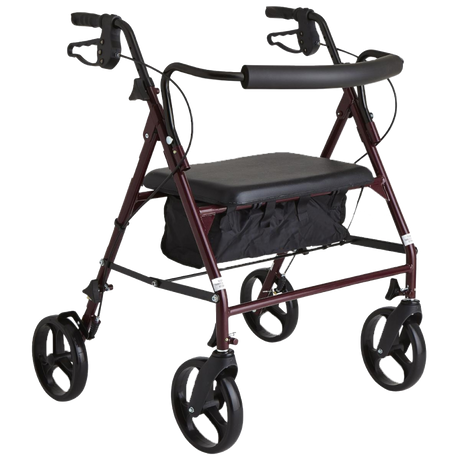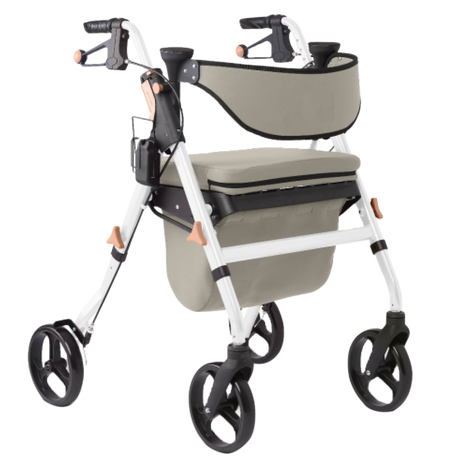If you or a loved one begin to experience declining mobility, it might be time to get a mobility aid. This is a great option if you find yourself dealing with medical conditions that impact your balance, gait, or leg strength or are recovering from knee, hip, or other lower limb surgeries or injuries. But it’s also a good fit for those who grow tired when walking long distances or who have balance issues.
If you are looking for an aid that still allows you to get around easily, can handle multiple terrains, and offers a variety of options, rollators might be the choice for you.
What is a Rollator?
A rollator, also known as a rolling walker, is an assistive device designed to assist individuals with walking difficulties. It typically consists of a lightweight frame with four wheels, handlebars for steering and support, and a built-in seat for resting. Rollators offer stability and balance while walking, allowing users to move more confidently and comfortably both indoors and outdoors. Rollators differ from walkers due to their wheeled legs.
Many models also feature handbrakes for added safety and control, as well as storage compartments for carrying personal belongings. Rollators come in various styles and configurations to suit different needs, making them a versatile and indispensable tool for individuals seeking greater independence and mobility.
What is a Rollator Walker Used For?
A rollator is used as a mobility aid, helping to steady a person while walking, while still allowing for maximum mobility. Most rollators have a fixed or fold-up seat on which a person can sit, which also makes rollator walkers ideal for those who fatigue easily and need to rest while on-the-go. Rollators are more “all-terrain” than traditional walkers, making them the ideal mobility device for those who enjoy time outdoors or have a more active lifestyle. Ultimately, rollators are designed to enhance balance and walking speed while being used and are perfect for use over long distances.
Enhanced Mobility and Independence
Rollators play a pivotal role in enhancing mobility and fostering independence for users facing walking challenges. By providing stability and support, these ingenious mobility aids enable individuals to navigate various environments with greater confidence and ease. With the inclusion of features like adjustable handlebars and handbrakes, users can customize their rollators to suit their specific needs and preferences, ensuring a comfortable and secure walking experience. The built-in seats offer convenient resting spots, allowing users to take breaks whenever necessary without having to seek out nearby seating.
Furthermore, the storage compartments integrated into many rollator designs enable users to carry personal belongings and essentials, further enhancing their autonomy and freedom of movement. Overall, rollators empower individuals to maintain an active lifestyle, engage in daily activities, and navigate the world with newfound independence and dignity.
Stability and Support While Walking
Rollators are invaluable tools for providing enhanced stability and support to individuals during walking. With their sturdy frames and four-wheel design, rollators offer a reliable base, significantly reducing the risk of falls and accidents, especially for those with balance issues or weakness in their lower body. The handlebars provide additional support, allowing users to maintain proper posture and distribute their weight evenly as they move. Many rollators also feature handbrakes, giving users control over their pace and ensuring a safe and gradual stop when needed.
Additionally, the built-in seats offer a convenient resting option for users to take breaks and conserve energy during longer walks. Overall, the combination of these features makes rollators an essential aid for individuals seeking to improve their stability and confidence while walking, enabling them to move with greater ease and security.
Reduction of Strain on Joints and Muscles
Rollators provide a significant reduction of strain on joints and muscles, making them essential aids for individuals with mobility issues. The design of rollators, with their lightweight frames and four wheels, allows users to rely less on their muscles and joints for support while walking.
By providing a stable base, rollators distribute the weight of the user more evenly, thereby reducing the strain on joints such as the knees, hips, and ankles. This redistribution of weight helps alleviate pressure on muscles as well, making walking less strenuous and more comfortable.
Furthermore, the inclusion of features like adjustable handlebars ensures that users can maintain proper posture, further minimizing strain on the spine and upper body. As a result, rollators enable individuals to move with greater ease and less discomfort, promoting better mobility and overall well-being.
Portability and Ease of Use on the Go
Rollators excel in providing portability and ease of use on the go, making them indispensable companions for individuals with mobility challenges. Their lightweight yet sturdy construction, coupled with foldable designs in many models, allows for convenient transportation and storage when not in use. This portability enables users to take their rollators wherever they go, whether it's running errands, traveling, or simply enjoying outdoor activities.
Additionally, rollators are designed for intuitive use, with simple controls and ergonomic features that make maneuvering effortless. From adjustable handlebars to easy-to-operate brakes, rollators are engineered to provide a seamless walking experience for users of all ages and abilities. As a result, individuals can maintain their independence and freedom to move about with confidence and convenience, regardless of their surroundings.
Features of a Rollator
A rollator typically incorporates a range of features designed to enhance mobility and comfort for users. Its lightweight yet sturdy frame provides stability while walking, supported by four wheels that offer smooth navigation over various terrains. Overall, these features combine to make the rollator a versatile and indispensable aid for individuals seeking enhanced mobility and independence in their daily lives.
Frame
The frame of a rollator is a crucial component that contributes to its overall stability, durability, and usability. Typically constructed from lightweight yet robust materials such as aluminum or steel, the frame provides a sturdy foundation for the rollator's structure. This ensures that users can rely on the rollator for support while walking, without worrying about it buckling or collapsing under pressure.
Additionally, the frame is designed to be ergonomic, with smooth edges and adjustable features to accommodate users of varying heights and preferences. Some rollator frames are foldable, allowing for easy storage and transportation when not in use, further enhancing the rollator's convenience and portability. Overall, the frame serves as the backbone of the rollator, providing the foundation for its functionality and reliability in aiding individuals with mobility challenges.
Wheels
The wheels of a rollator are integral to its functionality, providing smooth and stable movement over different surfaces. Typically, rollators are equipped with four wheels, though some models may have three or even larger wheels for specialized purposes. These wheels are designed to be durable and capable of navigating various terrains, including indoors and outdoors, without compromising stability.
Many rollators feature swivel wheels at the front to enhance maneuverability, allowing users to easily turn and navigate tight spaces. The rear wheels are often larger and provide greater stability, especially when going over uneven surfaces or obstacles.
Some rollators come with pneumatic tires, which offer additional shock absorption for a smoother ride. Overall, the wheels of a rollator play a crucial role in ensuring that users can move with confidence and ease, regardless of the environment.
Brakes
Handle brakes are a standard feature on rollator walkers, helping users come to a quick stop or gradually stop if they’ve picked up too much speed when walking. It’s a great safety mechanism to help safely maintain balance and speed while using.
Handles and Grips
Handles and grips are essential components of a rollator, providing users with stability, comfort, and control while walking. Typically, rollators are equipped with ergonomic handlebars designed to accommodate different hand sizes and ensure a comfortable grip. These handles often feature padding or textured surfaces to prevent slippage and reduce hand fatigue during prolonged use.
Additionally, many rollators have adjustable handlebar heights, allowing users to customize the fit according to their preferences and posture. Integrated handbrakes are common features on rollators, positioned within easy reach of the handles, enabling users to control their speed and stop safely when needed.
Overall, the handles and grips on a rollator are meticulously designed to offer users optimal support and confidence, facilitating smoother and more comfortable mobility.
Seat and Storage Options
The seat and storage options on rollators add convenience and versatility to these mobility aids, making them invaluable companions for individuals with walking difficulties. Many rollators feature a built-in seat positioned between the handlebars, providing users with a convenient resting spot during walks. These seats are typically padded for comfort and foldable, allowing users to easily transition between walking and resting positions.
Furthermore, rollators often come equipped with storage options such as baskets, pouches, or trays, located beneath the seat or attached to the frame. These storage compartments offer ample space for carrying personal belongings, groceries, or medical supplies, allowing users to keep essential items within reach while on the go.
Types of Rollators
Every rollator also has different options in terms of the features they offer. Below, we’ll outline a couple key features to consider when choosing a rollator. For a comprehensive comparison of Because rollator walkers, check out our rollator shopping guide.
Height-Adjustable Rollators
Most rollator walkers have adjustable heights, so that you can lift or lower the handlebars for optimal height. These typically have a 4-6-inch variable. It’s also worth considering the seat height and making sure you can sit comfortably on the seat, with your feet flat on the floor. Since standard rollators are made for the “average” height, if you’re under 5’3” or over 6’, you may want to look into rollators designed specifically for short or tall people.
Folding Rollators
Many rollator models fold flat for easy storage and transportation. This is a nice feature for car and plane travel. This is becoming a pretty standard feature, even on more stylish models like our Pink Zebra Rollator, Heavy Duty Rollator, and our new Blue Aluminum Deluxe Rollator. In fact, all of the rollators offered through because are foldable!
Indoor/Outdoor Rollators
Since standard rollators have four wheels that typically range from 6-8 inches in diameter, they’re ideal for indoor use and outdoor use. The size of the wheels allows for easy travel over uneven terrain like gravel, cobblestone, or pavers.
Four-Wheel Rollators
Four-wheeled rollators provide enhanced stability and support, making them ideal for individuals who require more balance assistance. With four wheels evenly distributing weight, these rollators offer a steady platform for walking over various terrains, indoors or outdoors. Additionally, they often come equipped with a built-in seat and storage options for added convenience during longer outings.
Three-Wheel Rollators
While a four-wheeled rollator is most common and the standard choice, three-wheeled options are available. They’re smaller and lighter than standard rollators, so they can fit in smaller spaces. They also have increased maneuverability and can make sharper turns. However, the design of a three-wheel rollator means it doesn’t offer a seat, so it’s not the best choice for those who experience fatigue when walking.
Who Should You Use a Rollator?
Determining when to use a rollator involves assessing one's mobility needs and considering various factors that may affect daily activities. Individuals experiencing difficulty with walking, balance, or fatigue may benefit from using a rollator to enhance stability and support while moving around. Common indications for using a rollator include recovering from surgery or injury, managing chronic conditions like arthritis or multiple sclerosis, or simply experiencing age-related mobility challenges.
Anyone with Mobility Challenges
Mobility challenges are a clear indicator of the need for mobility aids such as rollators. Individuals facing difficulties with walking, balance, or stamina due to various factors such as aging, injury, or medical conditions can greatly benefit from using a rollator.
Signs of mobility challenges may include:
- Struggling to stand for extended periods
- Frequent falls or near falls
- Feeling unsteady while walking
- Experiencing pain or discomfort during movement
Those Recovering from Surgery or Injury
Individuals recovering from surgery or injury often experience temporary mobility challenges due to factors such as pain, weakness, and restricted movement. In such cases, a rollator can be an invaluable aid in facilitating a smoother and safer recovery process. By providing stability and support while walking, a rollator helps reduce the risk of falls and minimizes strain on healing muscles and joints.
People with Chronic Health Conditions
People with chronic health conditions often face ongoing challenges related to mobility, balance, and stamina. In such cases, a rollator can offer significant benefits by providing support and assistance with walking. For individuals with conditions like arthritis, multiple sclerosis, or Parkinson's disease, a rollator can help reduce the strain on joints and muscles, making it easier and less painful to move around. In a a study on patients with Parkinson's Disease, researchers found that rollator use resulted in significantly reduced fall rate, number of falls, and injury rate compared to those who did not use rollators.
Seniors who Tire Easily
You should use a rollator if you tire easily when walking, as the built-in seat allows for resting. However, make sure that you’re steady enough on your feet that you can brake and stop the rollator without losing your balance. If you’re unsteady on your feet to the point of falling, you risk more falls when trying to brake, adjusting the wheels or turning, or when going downhill.
Sources:
U.S. Department of Transportation. (2023, Dec. 11). Wheelchairs and other assistive devices. Aviation Consumer Protection. Retrieved from https://www.transportation.gov/individuals/aviation-consumer-protection/wheelchairs-and-other-assistive-devices
Alkjaer T, Larsen PK, Pedersen G, Nielsen LH, Simonsen EB. Biomechanical analysis of rollator walking. Biomed Eng Online. 2006 Jan 6;5:2. doi: 10.1186/1475-925X-5-2. PMID: 16398933; PMCID: PMC1334195.
Okuyama K, Matuo Y. Effects of a rollator on fall prevention in Community-Dwelling people with Parkinson's Disease: A prospective cohort study. Clin Park Relat Disord. 2023 Feb 22;8:100190. doi: 10.1016/j.prdoa.2023.100190. PMID: 36879629; PMCID: PMC9984883.









